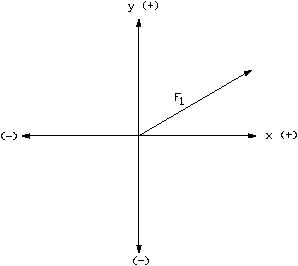GRAPHIC METHOD OF VECTOR ADDITION
Vectors
CP-02
Page 16
Rev. 0
Figure 16 Rectangular Coordinate System
GRAPHIC METHOD OF VECTOR ADDITION
Vectors are added to determine the magnitude and direction of the resultant.
EO 1.3
ADD vectors using the following methods:
a.
Graphical
Vector Addition
Component vectors are added to determine the resultant vector. For example, when two or
more forces are acting on a single object, vector addition is used to determine the direction and
magnitude of the net (resultant) force on the object. Consider an airplane that travels due east
for 100 miles at 500 mph, then NE for 50 miles at 400 mph, and finally north for 500 miles at
500 mph. Vector addition can be used to determine the net distance the airplane is from its point
of origin or to predict when it will arrive at its destination.
Methods Used to Add Vectors
Several methods have been developed to add vectors. In this chapter, the graphic method will
be explained. The next chapter will explain the component addition method. Either one of these
methods will provide fairly accurate results. If a high degree of accuracy is required, an
analytical method using geometric and trigonometric functions is required.
Using the Graphic Method
Before attempting to use this method, the
following equipment is needed: standard linear
(nonlog) graph paper, ruler, protractor, and pencil.
The graphic method utilizes a five-step process.
Step 1.
Plot the first vector on the
rectangular (x-y) axes.
a.
Ensure that the same
scale is used on both
axes.
b.
Place the tail (beginning)
of the first vector at the
origin of the axes as
shown in Figure 16.


